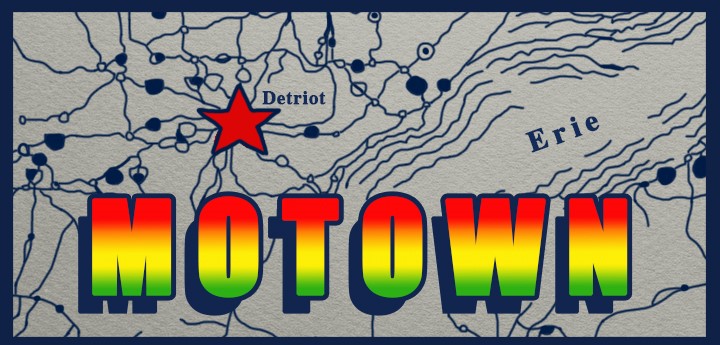Motown Records scaled new heights in 1971, the label’s final year in its physical and spiritual home of Detroit, Mich. prior to relocating to Los Angeles. The year kicked off with Marvin Gaye’s “What’s Going On” — the title track of his then-forthcoming LP, arguably the most celebrated release in the Motown canon — and continued with classics from established acts and newcomers alike. Here are five singles underlining the ongoing evolution and expansion of the Motown Sound.
“What’s Going On” – KORD-0050
Motown founder Berry Gordy Jr. conceived the company as a paragon of integration and inclusion, a hit factory producing music for audiences of all races and creeds — and to that end, Motown in its early years assiduously avoided overt political statements. “What’s Going On” wasn’t the first Motown hit to challenge Gordy’s mandate, but it was the most impactful, condemning America’s ongoing involvement in the Vietnam War by spotlighting the conflict’s effects on the lives of both the young men sent overseas and the families they left behind. The Four Tops’ Renaldo “Obie” Benson penned the first version of “What’s Going On” after witnessing a police attack on antiwar protesters; when the other members of the venerable vocal quartet declined to record the song, Benson presented it to Gaye, who added a new melody and new lyrics, drawing inspiration from the wartime experiences of his brother and cousin (the latter one of the more than 58,000 Americans killed in combat). The resulting single, which Gaye produced himself, is both searing and soaring, a gospel-inspired celebration of peace, love and understanding in the face of American brutality and bloodlust. While “What’s Going On” went on to sell more than two million copies, liberating artists like Gaye and Stevie Wonder to make increasingly personal, ambitious records, Gordy initially discouraged Gaye from recording the song, saying “Don’t be ridiculous. That’s taking things too far.” Given that America still refuses to learn from its mistakes more than half a century later, perhaps Gaye didn’t take things far enough.

“Just My Imagination (Running Away with Me)” – KORD-0063
The ethereal “Just My Imagination (Running Away with Me)” shimmers and sighs, elevating the everyday pathos of unrequited longing into the realm of sugar-spun fantasy. While producer Norman Whitfield’s fingerprints are all over the single’s celestial orchestral arrangement, it’s first and foremost a throwback to the timeless Temptations ballads of yesteryear: its narrator is a lovelorn man in thrall to a woman who passes his window each day, and he dreams of the life they might someday share (“A cozy little home out in the country with two children, maybe three”). Reality inevitably pulls him out of his reverie: they’ve never even met, and she doesn’t know he exists. There’s no trace of malice in his fantasies, no threat of violence, but whatever the obstacles keeping them apart, they are insurmountable, and he has resigned himself to his fate. Credit the Temptations for making “Just My Imagination” neither mawkish nor melodramatic: their harmonies have never been more beautiful or more unified, and Eddie Kendricks’ heartrending falsetto is sublime.

“Never Can Say Goodbye” – KORD-0064
The sinuous “Never Can Say Goodbye” proved the Jackson 5 could make music as mature and sophisticated as any of their more established Motown peers. Written by future sitcom star Clifton Davis and originally intended for the Supremes, “Never Can Say Goodbye” explores themes of romantic turmoil wholly absent from previous J5 hits like “ABC” and “The Love You Save,” calling on 12-year-old Michael Jackson to interpret decidedly adult lyrics like “Even though the pain and heartache/Seem to follow me wherever I go” — and resulting in his most complex lead vocal turn to date. (Isolate Jackson’s performance here in KORD to experience the extraordinary scope of his preternatural talent.) Although Motown A&R execs were initially reluctant to release “Never Can Say Goodbye,” fearing it vaulted the Jacksons too far past the puppy-love pabulum of teen rivals like the Osmonds, Berry Gordy ultimately pulled rank, and the group scored its biggest hit since “I’ll Be There” a year earlier.
The song itself has been covered many times, including a 1974 version by Gloria Gaynor.

“Smiling Faces Sometimes” – KORD-0065
The Undisputed Truth was a vocal trio assembled by the aforementioned Norman Whitfield, the Motown staff producer responsible for psychedelic soul classics including the Temptations’ “Cloud Nine” and Edwin Starr’s “War.” The dense, forbidding “Smiling Faces Sometimes”is among several major R&B hits of the early 1970s to address the disillusionment and dread gripping Black Americans as they struggled to navigate the nation’s post-civil rights landscape — a white patriarchal society where no one can be trusted, and where nothing is what it seems. “Smiling faces sometimes/Pretend to be your friend,” sings the Undisputed Truth’s Joe “Pep” Harris. “Smiling faces show no traces/Of the evil that lurks within.” The success of “Smiling Faces Sometimes” resulted in a flurry of “answer” records grappling with the same paranoia and angst, most notably the Staple Singers’ chart-topping “I’ll Take You There” and the O’Jays’ Philly soul classic “Back Stabbers,” both from 1972.

“I Just Want to Celebrate” – KORD-0066
Detroit funk-rock combo Rare Earth was an anomaly within the Motown ranks — so much so that the all-white group was awarded its own vanity label, Rare Earth Records, dedicated to white rock acts. The don’t-let-the-bastards-get-you-down anthem “I Just Want to Celebrate,” written by Motown staffers Dino Fekaris and Nick Zesses, boasts one of the monster guitar riffs of its year (or any other year, for that matter) as well as a raucous lead vocal from drummer Peter Rivera, and if it doesn’t sound anything like the other Motown classics in this playlist, that’s entirely the point: more than a decade into its existence, the label refused to be pigeonholed.







